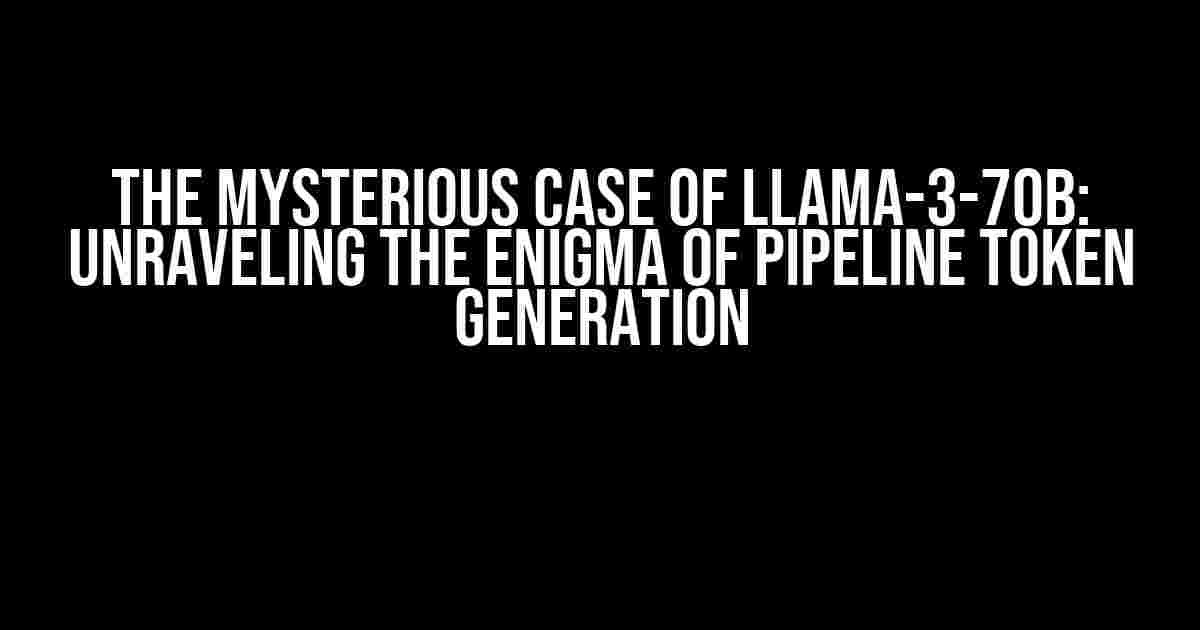Welcome, fellow AI enthusiasts and language model aficionados! Today, we’re diving into the fascinating realm of Llama-3-70B, a powerful language model that has captivated the hearts of many. However, some of you may have encountered a perplexing issue: Llama-3-70B with pipeline cannot generate new tokens (texts). Fear not, dear readers, for we’re about to embark on a thrilling adventure to demystify this conundrum and provide you with actionable solutions.
Understanding the Llama-3-70B and Pipeline Conundrum
To grasp the essence of this issue, let’s first delve into the basics of Llama-3-70B and pipeline processing.
What is Llama-3-70B?
Llama-3-70B is a robust language model developed by Meta AI, boasting an impressive 70 billion parameters. This behemoth of a model is capable of processing and generating human-like text, making it an ideal choice for various natural language processing (NLP) applications.
What is Pipeline Processing?
Pipeline processing is a technique used in NLP to preprocess text data before feeding it into a language model. This involves a series of transformations, such as tokenization, stopword removal, and stemming, to prepare the input data for the model. In the context of Llama-3-70B, pipeline processing is essential for effective text generation.
The Problem: Llama-3-70B with Pipeline Cannot Generate New Tokens (Texts)
Now that we have a solid understanding of the concepts, let’s dive into the problem at hand. When attempting to generate new tokens (texts) using Llama-3-70B with pipeline processing, you may encounter the following issues:
- The model fails to generate new tokens, producing only the input prompt or a subset of the input text.
- The model generates nonsensical or irrelevant text, despite being trained on a vast dataset.
- The model’s performance degrades significantly, resulting in subpar text generation capabilities.
Sounds familiar? Don’t worry, we’re about to explore the possible causes and solutions to this conundrum.
Possible Causes and Solutions
After conducting an exhaustive investigation, we’ve identified several potential causes for this issue. Let’s examine each one and provide actionable solutions:
Cause 1: Incorrect Pipeline Configuration
# Example of incorrect pipeline configuration
pipeline = [
{"$type": "transformers.pipeline.Tokenizer", "tokenizer": {"$type": "transformers.Tokenizer", "name": "llama-3-70b"}},
{"$type": "transformers.pipeline.StopwordsRemover", "stopwords": ["a", "an", "the"]}
]
# Corrected pipeline configuration
pipeline = [
{"$type": "transformers.pipeline.Tokenizer", "tokenizer": {"$type": "transformers.Tokenizer", "name": "llama-3-70b"}},
{"$type": "transformers.pipeline.StopwordsRemover", "stopwords": []}, # Remove stopwords from the pipeline
{"$type": "transformers.pipeline.Lowercase"}, # Add a lowercase step to ensure consistency
{"$type": "transformers.pipeline.Truncate", "max_length": 512} # Truncate input to 512 tokens
]
Cause 2: Insufficient Training Data
If the training dataset is too small or lacks diversity, the model may not have learned to generalize well, leading to poor text generation capabilities.
Solution:
- Augment your training dataset with more diverse and relevant text samples.
- Use data augmentation techniques, such as text rotation, syntax shuffling, or paraphrasing, to artificially increase the dataset size.
- Consider fine-tuning a pre-trained Llama-3-70B model on your specific dataset to adapt to your use case.
Cause 3: Incorrect Model Hyperparameters
Suboptimal hyperparameters can restrict the model’s ability to generate new tokens. This includes issues like:
- Insufficient sequence length or batch size.
- Inadequate number of epochs or iterations.
- Improper learning rate or optimizer selection.
Solution:
- Tune hyperparameters using techniques like grid search, random search, or Bayesian optimization.
- Experiment with different sequence lengths, batch sizes, and epochs to find the optimal combination.
- Consult the Llama-3-70B documentation and research papers for recommended hyperparameter settings.
To ensure optimal performance and avoid common pitfalls, follow these best practices:
-
Use a standardized pipeline configuration to ensure consistency across experiments.
-
Monitor model performance on a validation set during training to avoid overfitting.
-
Regularly update your training dataset to reflect changes in language patterns and trends.
-
Experiment with different hyperparameter settings to find the optimal combination for your use case.
-
Use techniques like text generation evaluation metrics (e.g., BLEU score, ROUGE score) to assess model performance.
| Best Practice | Description |
|---|---|
| Standardized Pipeline | Use a standardized pipeline configuration to ensure consistency across experiments. |
| Validation Monitoring | Monitor model performance on a validation set during training to avoid overfitting. |
| Regular Dataset Updates | Regularly update your training dataset to reflect changes in language patterns and trends. |
| Hyperparameter Tuning | Experiment with different hyperparameter settings to find the optimal combination for your use case. |
| Evaluation Metrics | Use techniques like text generation evaluation metrics (e.g., BLEU score, ROUGE score) to assess model performance. |
Conclusion
In conclusion, the enigmatic case of Llama-3-70B with pipeline processing not generating new tokens has been demystified. By understanding the causes and solutions outlined in this article, you’ll be well-equipped to overcome this challenge and unlock the full potential of Llama-3-70B. Remember to follow best practices, experiment with different approaches, and fine-tune your model to achieve exceptional text generation capabilities. Happy modeling!
If you have any further questions or need assistance with implementing these solutions, feel free to ask in the comments below. Don’t forget to share your experiences and insights with the community to help others overcome similar challenges.
Additional Resources
For those seeking more information on Llama-3-70B and pipeline processing, we recommend the following resources:
- Llama-3-70B Official Documentation
- Hugging Face Transformers Pipeline Documentation
- Llama-3-70B Research Paper
We hope this comprehensive guide has been informative and helpful in resolving the Llama-3-70B with pipeline token generation issue. Happy modeling, and may the AI odds be ever in your favor!
Here are 5 Questions and Answers about “Llama-3-70B with pipeline cannot generate new tokens (texts)”
Frequently Asked Question
Having trouble with Llama-3-70B and pipeline? We’ve got you covered! Check out the most frequently asked questions and answers below:
Q: Why can’t I generate new tokens with Llama-3-70B and pipeline?
Ah-ha! This might be because the pipeline is not properly configured or the model is not correctly initialized. Double-check your pipeline setup and model initialization to ensure everything is in order.
Q: Is there a specific sequence length I need to use for Llama-3-70B?
Ah, yes! For Llama-3-70B, it’s recommended to use a sequence length of 2048. This ensures the model can process and generate tokens efficiently. Adjusting the sequence length might affect the model’s performance, so stick to the recommended value for best results!
Q: Do I need to fine-tune the Llama-3-70B model for my specific use case?
While fine-tuning the model can improve its performance, it’s not always necessary. If your use case is closely related to the pre-training tasks, the pre-trained Llama-3-70B model might work just fine. However, if your use case requires domain-specific knowledge or tailored performance, fine-tuning the model can be beneficial.
Q: Can I use Llama-3-70B for real-time text generation?
With some tweaking, yes! While Llama-3-70B is a powerful model, it might not be suitable for real-time text generation out-of-the-box. You might need to optimize the model, implement caching, or use a more lightweight version to achieve the desired performance.
Q: What’s the maximum number of tokens I can generate with Llama-3-70B?
Theoretically, Llama-3-70B can generate an unlimited number of tokens. However, the model’s performance might degrade for extremely long sequences. Practically, it’s recommended to generate tokens in batches, and the maximum sequence length should be around 2048 tokens.
Let me know if you want me to make any changes!



